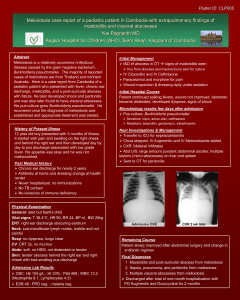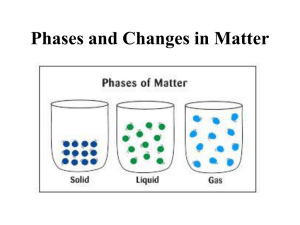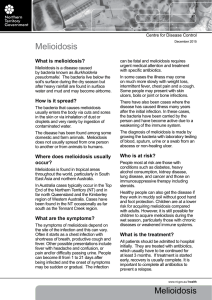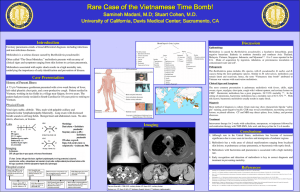PPT Limmathurotsakul 03
advertisement
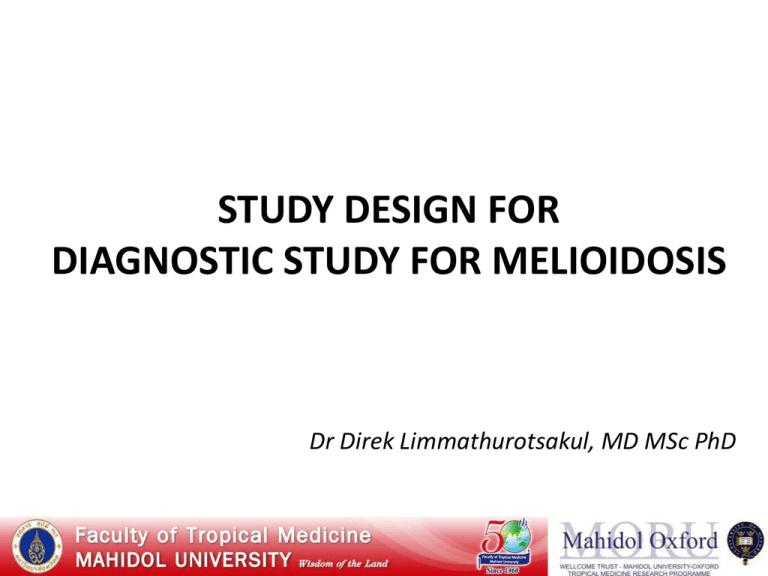
STUDY DESIGN FOR DIAGNOSTIC STUDY FOR MELIOIDOSIS Dr Direk Limmathurotsakul, MD MSc PhD Introduction: 3 phases of study design Laboratory phase Case-control phase Prospective phase - develop test - test with few cases and healthy controls - prove of concept - test with definite cases and definite controls - calculate Se & Sp - test with diseasesuspected patients - calculate Se, Sp, PPV & NPV Introduction: 3 phases of study design Laboratory phase Case-control phase Prospective phase - develop test - test with few cases and healthy controls - prove of concept - test with definite cases and definite controls - calculate Se & Sp - test with diseasesuspected patients - calculate Se, Sp, PPV & NPV Look promising Introduction: 3 phases of study design Laboratory phase Case-control phase Prospective phase - develop test - test with few cases and healthy controls - prove of concept - test with definite cases and definite controls - calculate Se & Sp - test with diseasesuspected patients - calculate Se, Sp, PPV & NPV Look promising Look good Introduction: 3 phases of study design Laboratory phase Case-control phase Prospective phase - develop test - test with few cases and healthy controls - prove of concept - test with definite cases and definite controls - calculate Se & Sp - test with diseasesuspected patients - calculate Se, Sp, PPV & NPV Look promising Look good Look rubbish (GS problem) Good guideline Good guideline • Recommendation 1: Access index test’s ability to predict patient-relevant outcomes instead of test accuracy • Recommendation 2: Access the concordance of difference tests instead of test accuracy • Recommendation 3: Qualify the interpretation of “naïve” estimates of the index test’s performance • Recommendation 4: Imperfect gold standard model Recommended design for melioidosis • Define need For example, estimate Se, Sp, PPV and NPV in a prospective design (to represent the real clinical situation) • Define study population (that we would like to infer the estimated accuracy to) • Next: select reference standard Recommended design for melioidosis • If there are more than one population, at least 2 diagnostic tests (3 tests are preferred) Those 2 tests should be based on 2 different biological mechanism (e.g. one antigen detection [culture] and one antibody detection [IHA]) • If there is only one population, at least 3 diagnostic tests (5 tests are preferred) Those 3 tests should be based on 3 different biological mechanism (e.g. one antigen detection [culture / PCR assays], one antibody detection [IHA/ELISA], one clinical detection [ultrasonogram/CT scan]) Recommended design for melioidosis • Consider repeated sampling and convalescent specimens • Day 4 and Day 7 specimens may have clinical implication for changing the diagnosis and treatment • Day 14 and Day 28 specimens may have clinical implication for starting oral treatment regimen • Consider long-term outcome for relapse/recurrent infection • Four-fold rising is arbitrary and based on imperfect gold standard. This should be evaluated with better approach • Adequate sample size is required (enough diseased patients for sensitivity estimation is important than the total number) Recommended design for melioidosis • • • • • • • • • Select sites Appoint study team Train staff Provide GCP Conduct QC and monitoring Collect data Perform analysis Report results using STARD checklist Disseminate results END





